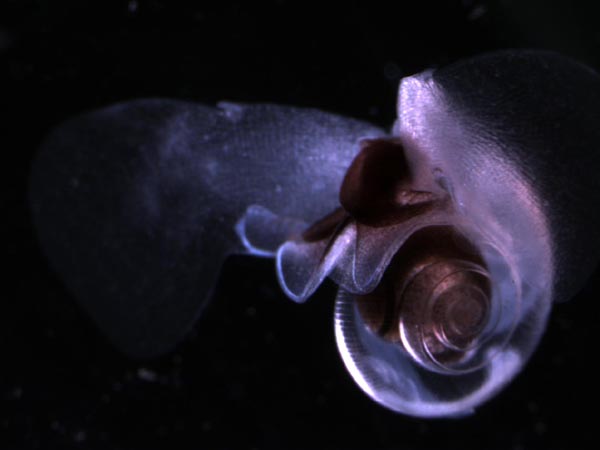- Limacina
Taxobox
name = "Limacina"

image_width = 240px
image_caption = "Limacina helicina"
regnum =Animal ia
subregnum =Metazoa
phylum =Mollusca
classis =Gastropoda
subclassis =Orthogastropoda
superordo =Heterobranchia
ordo =Opisthobranchia
subordo = Thecosomata
infraordo =Euthecosomata
superfamilia =Limacinoidea
familia =Limacinidae
genus = "Limacina"
subdivision_ranks = Species
subdivision =
*"Limacina bulimoides "
*"Limacina helicina "
*"Limacina helicoides "
*"Limacina lesueurii "
*"Limacina retroversa "
*"Limacina trochiformis ""Limacina" is a
genus of swimmingpredatory seasnail s commonly known as sea butterflies in the family Limacinidae (Blainville, 1823).These little snails are
pelagic , and they are marineopisthobranch gastropod mollusk s. They swim by flapping theirparapodia , and that flapping action is the reason why they were given thecommon name sea butterflies .The sea butterflies are part of the order Thecosomata. The
sea angels , which look a little similar and are also pelagic swimming snails, are in a different order, the Gymnosomata. Both of these orders are still sometimes called "pteropods"; the sea butterflies of the order Thecosomata have a shell, while the sea angels in the order Gymnosomata lack a shell.The sea butterflies evolved from fossil species dating back at least to the Middle
Miocene period. The family Limacinidae contains the genus Limacina and a new genus, only known from fossils, "Currylimacina".hell description
The shells of these sea butterflies are well developed, sinistrally coiled, turret-like and unpigmented. Shell sizes and thicknesses vary within Limacina, but they are still large enough to fit the snail. There is also an operculum. In Arctic and temperate waters, the diameter of the shell does not exceed 15 mm. In warmer waters, the diameter varies from 1 to 3 mm.
Description of the soft parts
There are two large winglike parapodia, derived from foot tissue. The sea butterflies are continually flapping these wings to prevent sinking, because the shell gives them some negative buoyancy. During the daytime, they tend to move to deeper waters, but no lower than 100 m.
Life habits
The sea butterflies have a peculiar way of feeding. They used to be regarded as passive feeders, but in reality they are active hunters, feeding mostly on plankton but also bacteria, small crustaceans, gastropod larvae, dinoflagellates and diatoms. They entangle their planktonic food through a mucous web that can be up to 5 cm wide, many times larger than themselves. This web is eaten as soon as there is enough food entangled and then a new one is soon deployed. This net also provides them additional buoyancy. If disturbed, they dump the net and flap away.There is a posterior footlobe with cilia, and a pair of lateral footlobes. They transport food, collected by the mucous web, to the mouth.
When they migrate to the surface, they may do so in unbelievably huge numbers. These aggregations usually attract their predators, the sea angels of the genus Clione (family
Clionidae , suborderGymnosomata ). They are also on the menu ofbaleen whale s, chunk salmon, pink salmon, herring [ [http://www.afsc.noaa.gov/Quarterly/jas2005/divrptsABL1.htm Quarterly research reports for Auke Bay Lab, July-Sept 2005 - page 1 ] ] and certainseabird s.pecies and subspecies within the genus "Limacina"
Genus Limacina Bosc, 1817
*"Limacina bulimoides" ((d'Orbigny, 1836) -- Bulimoid Pteropod
**Distribution : Red Sea, Pacific
**Length : 1.2 mm
* "Limacina helicina" (Phipps, 1774) -- Helicid Pteropod
**Distribution : North America, Western Atlantic, East Pacific, Antarctic, Arctic Ocean
**Subspecies :
***"Limacina helicina acuta" Van Der Spoel, 1967
***"Limacina helicina helicina" Phipps, 1774
***"Limacina helicina pacifica" (Dall, 1871
* "Limacina helicoides" Jeffreys, 1877
* "Limacina inflata" (d'Orbigny, 1836) -- Planorbid Pteropod
**Distribution : circumglobal, Red Sea, Pacific
**Length : 1 mm
**Description : the shell is flatly twisted, resembling the shell of the cephalopodNautilus .
*"Limacina lesueurii" ((d'Orbigny, 1836)
**Distribution : North America, Western Atlantic
*"Limacina retroversa" (Fleming, 1823) -- Retrovert Pteropod
**Distribution : North America, Western Atlantic, Arctic Ocean.
*"Limacina trochiformis" ((d'Orbigny, 1836) -- Trochiform Pteropod
**Distribution : North America, Western Atlantic, Red Sea, Pacific
**Length : 1 mmReferences
Wikimedia Foundation. 2010.
